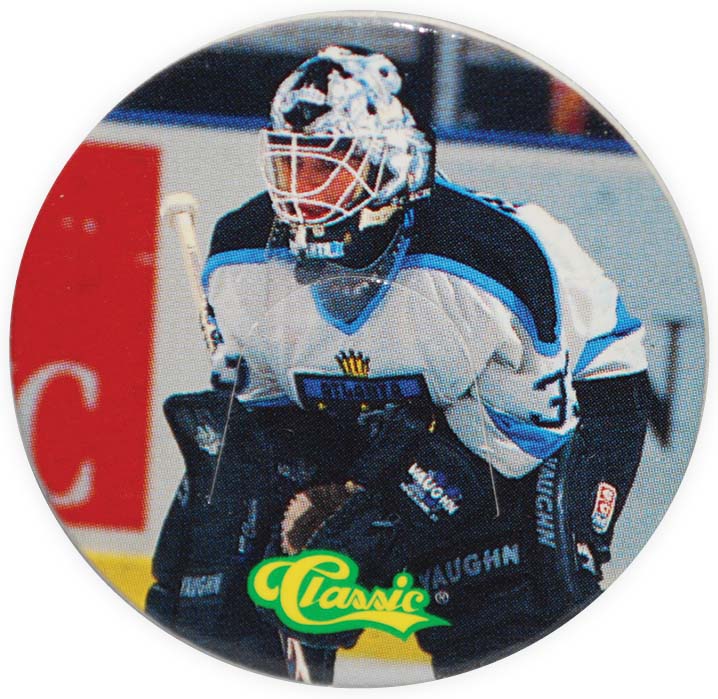THE WOMEN’S GAME
★ ★ ★
The sport of hockey has evolved a great deal since its early days. The number of players on the ice has changed; the equipment has changed; heck, the very look of the ice, now bedecked in advertisements, is immensely different from what it was just a couple short decades ago.
But the single biggest change in hockey in the last two decades has been the growth of the women’s game. What was once an offshoot of the men’s game has now grown to become an entity unto its own.
COMPETITION
In the women’s game, the ultimate rivalry is between not two league teams but two nations: Canada and the United States of America. The women’s game really broke through in 1990 when the International Ice Hockey Federation (IIHF) staged the first Women’s World Hockey Championships; and each and every final series since has been played between Canada and the United States.

DELANEY COLLINS
In part because of the heated play, women’s hockey has grown by leaps and bounds, with participation in North America on a sharp incline, particularly thanks to the inclusion of the sport in the Winter Games, starting in 1998.
“We’ve seen how much the game has changed in the last 15 years. It’s been dramatic,” says three-time Olympian Jennifer Botterill. “We’ve just seen how many girls are starting to sign up for hockey. It’s so drastically different from where it was years ago, and I think the Olympics are a huge part of that.”
With men’s teams having been so dominant for years, not every market — no matter how hockey mad — will take up interest in the women’s game.
“I think there’s a really fine line between drawing people to the women’s game and competing with male professional sports. There are certain cities and places where women’s hockey is off-the-charts popular, and then there are cities where you’d think it’s popular and it simply doesn’t take off,” says Delaney Collins, who played defence for Team Canada and in the Western Women’s Hockey League (WWHL). “I found in Calgary, women’s hockey never truly thrived, even with Hockey Canada there. The Oval Extreme, even with a handful of Olympians, never really drew a lot of fans; but if women’s hockey goes to Winnipeg, the city turns upside down and you can’t get a ticket.
“I’m coaching in Erie, PA, at Mercyhurst, where the women’s game is thriving, and I think that adds to my job satisfaction.”
Where women have differentiated themselves is in their efforts to reach out to fans. While hockey players in general are known as some of the most fan-friendly athletes in all of sport, women’s players have gone that extra mile, readily handing priceless mementos to their young fans. “I ended up giving my [Olympic] jacket to a girl I knew who was sick,” Botterill recalls. “When you can give someone else in your life value, it’s pretty special. You keep some stuff, but if you can have an impact for other people too, you like to share some of that.”
That impact can also be seen in the variety of charitable work performed by women’s hockey players. Whether it’s organized efforts at the team or national levels or on a personal level, women’s hockey players have generously given back to the communities that have supported them or need their help. Collins attributes this to the nature of the sport. “Women’s hockey has more of a personal tie to fundraising because the women aren’t making comparable salaries to professional male athletes. They know what it’s like to raise money, and I think women see more value in raising money. It becomes a personal reflection of themselves,” she says, adding that a lot of the effort comes as a result of national initiatives and the effect that follows.

JON WALDMAN
“In particular, the Canadian women’s team does a lot of fundraising, and now that’s trickling down to the women’s leagues. At Mercyhurst, we do different fundraising, and one of the evenings we do is for breast cancer. It’s pretty neat. Generally, there are ties to these players and raising these funds.”
CROSSOVERS
Though several women’s players have become hobby darlings simply in their own competition, others made headlines by moving over to the men’s game.
Most famous of these women is Manon Rheaume. In 1992, Rheaume broke the gender barrier by suiting up with the Tampa Bay Lighnting during the 1992–93 NHL pre-season. The move had its skeptics, who figured the new club was attempting a publicity stunt, but the intent of bringing Rheaume to the tryouts was genuine, as she had the skills and had also previously played against males in the QMJHL and Junior-A leagues. Though Rheaume didn’t make the Lightning roster, she was able to find a spot in the International Hockey League, first with the Atlanta Knights and later with a variety of other clubs, while also backstopping the Canadian Women’s team in the Women’s World Hockey Championships.
A few years later, the NHL again came calling to the women’s game as Hayley Wickenheiser was invited to the Philadelphia Flyers’ rookie camp in 1998 and 1999. Wickenheiser was already a very familiar name to hockey fans, having started in the national women’s program at age 15, winning gold in her first year. Up until this time, most women who had crossed over to the men’s game were goaltenders, but Wickenheiser showed that she could more than hang with the boys, and she would go on to play in Europe and become the first woman to score a goal in a men’s pro league.
While Rheaume and Wickenheiser received more hobby attention — both from manufacturers and collectors — as a result of their play, their popularity is hardly isolated.